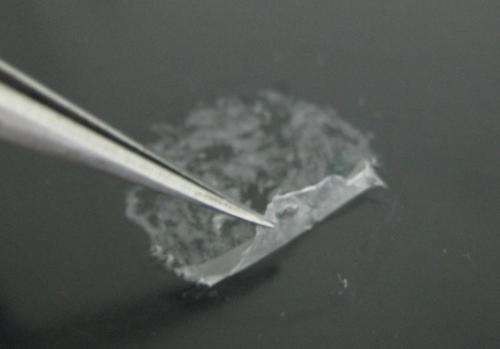Like cling wrap, new biomaterial can coat tricky burn wounds and block out infection

Wrapping wound dressings around fingers and toes can be tricky, but for burn victims, guarding them against infection is critical. Today, scientists are reporting the development of novel, ultrathin coatings called nanosheets that can cling to the body's most difficult-to-protect contours and keep bacteria at bay.
The researchers are speaking about their materials, which they've tested on mice, at the 248th National Meeting & Exposition of the American Chemical Society (ACS).
Yosuke Okamura, Ph.D., explains that existing wound dressings work well when it comes to treating burns on relatively flat and broad areas. But the human body has curves, wrinkles and ridges that present problems for these dressings. So Okamura's team developed a novel biomaterial out of tiny pieces of nanosheets that are super-flexible and sticky.
"The nanosheets can adhere not only to flat surfaces, but also to uneven and irregular surfaces without adding any adhesives," he says.
That would make a big difference in the way burn victims are treated. According to the Centers for Disease Control and Prevention, someone is injured by fire every 30 minutes. Burn wounds are vulnerable to infection, and keeping them sealed off from bacteria is essential for a successful recovery.
Okamura's team at Tokai University makes the nanosheets out of a biodegradable polyester called poly(L-lactic acid), or PLLA. They put the material into a test tube with water and spin it, which breaks up the sheets into even smaller pieces. When they pour the liquid onto a flat surface, the tiny fragments overlap in a patchwork and dry as a single nanosheet.
They tested out the nanosheets' ability to coat small and irregular shapes by dipping different things into the mixture, including a metal needle and a mouse's fingers. The nanosheet patchwork effectively covered even the smallest bumps and wrinkles on the mouse's digits, and after the material dried, it clung in place.
When the researchers tested the nanosheets on burns, the dressing effectively kept out the common bacteria, Pseudomonas aeruginosa. This species of pathogen is often a culprit in skin infections and is notorious for causing hospital-acquired infections that can be deadly. Multi-drug resistant strains are also a serious concern.
The dressing protected wounds from infection for three continuous days. With an additional coating, the nanosheets kept bacteria out for a total of six days. That means the material, if eventually approved for human patients, could cut down the number of times dressings have to be changed. With an eye toward human clinical trials, the researchers are currently planning large-scale animal tests and safety tests.
In addition to PLLA nanosheets, Okamura's group has recently started developing a novel set of similar, super-flexible, patchwork coatings composed of polymers with a phosphorylcholine group. They have shown that these materials are compatible with blood and could act as coatings for medical devices, such as catheters.
More information: Title: Development of fragmented nanosheets and patchwork coating as aqueous surface modifiers for biomedical applications
Abstract
Free-standing ultra-thin films (often called nanosheets) composed of biocompatible polymers (size >cm, thickness <100 nm) represent unique properties as good adhesiveness, exquisite flexibility, and a high degree of transparency1). However, they are often hard to coat irregular/uneven interfaces due to the structural aspect (cm-size). In this paper, we propose a novel nanobiomaterial "fragmented nanosheets" to effectively coat the uneven interfaces and a patchwork coating as an aqueous surface modifier for biomedical applications. Free-standing nanosheets composed of biodegradable poly(L-lactic acid) (PLLA) with a thickness of 60 ± 6 nm were successfully mass-produced by a simple combination of a spin-coating-assisted multi-layering process of poly(vinyl alcohol) and PLLA and a peeling technique. Intriguingly, the PLLA nanosheets could be easily fragmented by homogenization at 30,000 rpm and then reconstructed into a sheet on various interfaces (steels, glasses, plastics and skin) without any adhesive reagents. The adhesion behavior resembled a "patchwork", which was evident as a sequential series of structural colors on the substrate. For a biomedical application, we demonstrated that the patchwork coating of fragmented nanosheets acts as an excellent barrier against burn wound infections by Pseudomonas aeruginosa2). This material thus constitutes a promising alternative to conventional therapy for burn patients. We will also propose that the patchwork coating of other biocompatible polymers (polyimide and polyurethane etc.) containing phospholipid moiety3) converts various substrates to blood-compatible surfaces.
References:
1. Okamura, Y. et al. Adv. Mater. 21, 4388-92 (2009).
2. Okamura, Y. et al. Adv. Mater. 25, 545-51 (2013).
3. Nagase Y. et al. Biomedical Engineering - Frontiers and Challenges, Chapter 11, 217-232, InTech, Croatia (2011).
Provided by American Chemical Society



















